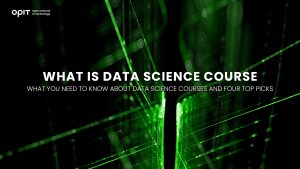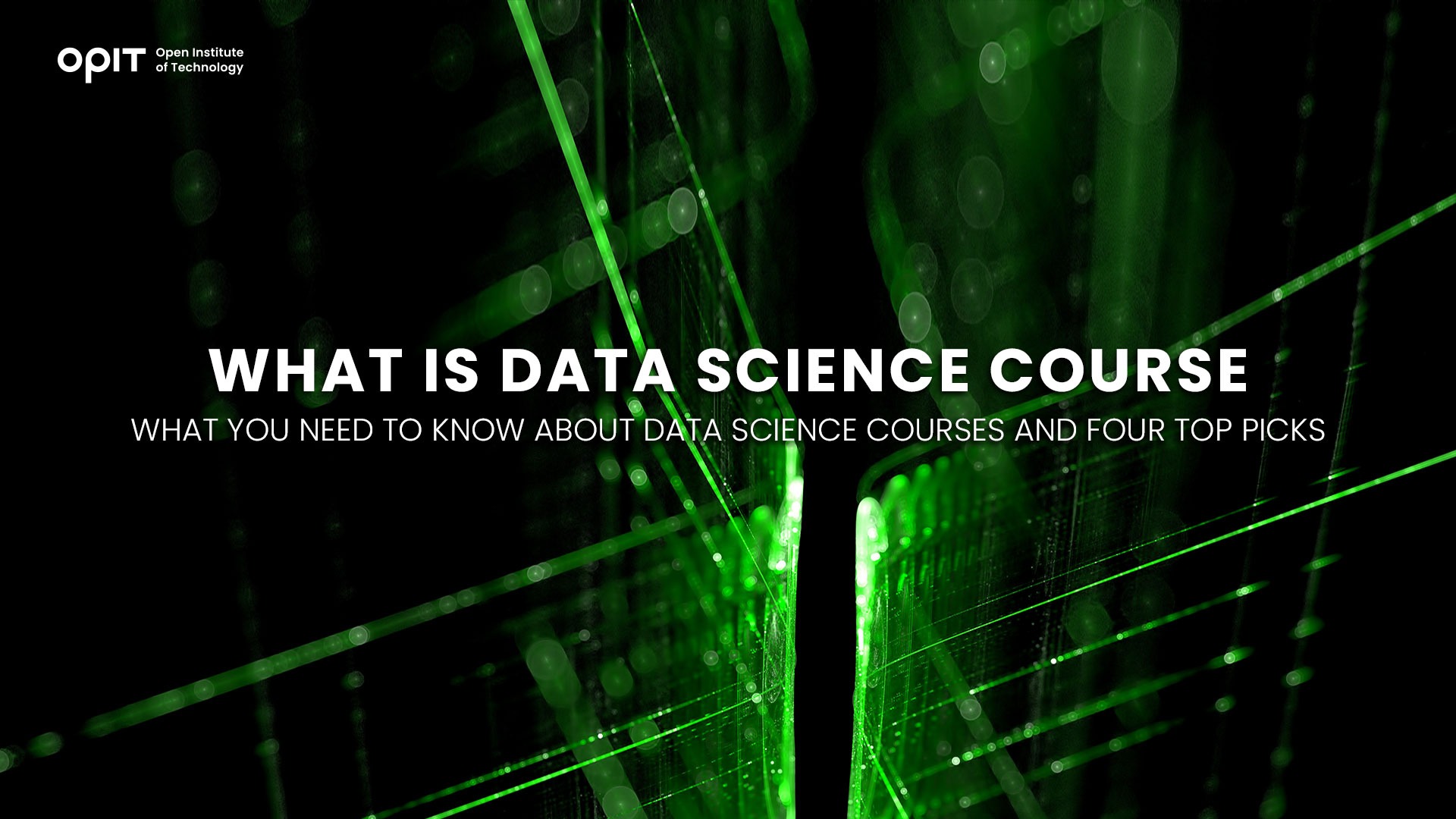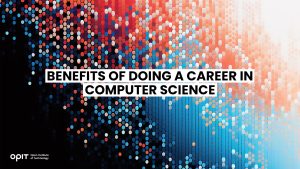

Combine mathematics with analytics, mix in programming skills, and add a dash of artificial intelligence, and you have the recipe for creating a data scientist. These professionals use complex technical skills to parse, analyze, and draw insights from complex datasets, enabling more accurate decision-making in the process.
As companies gather more data than ever before (both about their customers and themselves), these skills are in increasingly high demand. That’s demonstrated by data from the U.S. Bureau of Labor Statistics, which says that the number of data science jobs in the U.S. alone looks set to increase by 36% between 2021 and 2031.
That higher-than-average growth rate creates an opportunity for students, though grasping that opportunity requires a dedication to learning. This article explores the question of what is data science course material and highlights a selection of courses that set you on a data-propelled career path.
What to Expect From a Data Science Course
Answering the question of “what is data science course?” starts with examining the components of the typical course. Bear in mind that these components vary in nature and complexity depending on the specific course you take, though all are usually present.
Overview of Course Content
The content of a data science course is usually split into four core categories:
- Statistics and Probability – Math underpins everything a data scientist does, as they use numbers to spot patterns and determine the likelihood of various potential outcomes. Most data science courses delve into statistics and probability for this reason, with more advanced courses often requiring a degree in a field related to these areas.
- Programming – Whether it’s Python (the most popular data science programming language), R, or SQL, your course will teach you how to write in a language that machines understand.
- Data Visualization and Analysis – Anybody can collect reams of data. It’s the ability to visualize that data (and draw insights from it) that sets data scientists apart from other professionals. A good course equips you with the ability to use visualization tools to shine a spotlight on what a dataset actually tells you.
- Machine Learning and AI – The rise of machine learning transformed data science. Using algorithms created by data scientists, machines can analyze datasets presented to them and learn from the patterns to predict probabilities for different outcomes and even predict market trends. Your course will teach you how to create the algorithms that serve as a machine learning model’s “brain.”
Hands-On Projects and Real-World Applications
If you had the desire, you could read pages and pages on how to tune a car’s engine. But without practical and real-world wrench-in-hand experience working on an engine, you’ll never figure out how what you learn from books applies in the field.
The same line of thinking applies to data science, which is often so technically complex that it’s difficult to see how what you learn applies in the real world. A good data science course incorporates a real-world component through projects and exposure to faculty members who have direct experience in using the skills they teach.
Peer Collaboration and Networking
What is data science course for if not to learn how to become a data scientist? While learning the technical side is crucial, of course, a good course also puts you in contact with like-minded individuals who have the same (or similar) goals as you.
That contact helps you to build the collaborative skills you’ll need when you enter the workforce. But perhaps more importantly, it aids you in creating a network of peers who could lead you to job opportunities or work with you on entrepreneurial ventures.
Top Data Science Courses Available
With the components of a data science course established, you have a vital question to answer – what data science course should you take? The following are four suggestions (two online courses and two university courses) that give you a solid grounding in the subject.
Online Courses
Taking a data science course online gives you flexibility, though you may miss out on some of the collaborative and networking aspects that university-led courses provide.
Course 1 – What Is Data Science? (IBM via Coursera)
Coming with the stamp of approval from IBM, a leading name in the computer science field, this nine-hour course is suitable for beginners who want a self-paced learning approach. It’s part of a multi-part program (the IBM Data Science Professional Certificate) that’s designed to give you an industry-recognized qualification that could fast-track your entry into the field.
As for the course itself, it’s split into three parts, each containing multiple instructor-led videos and quizzes to test what you’ve learned. By the end, you’ll understand what data scientists do, build a basic understanding of various data science-related topics, and see how the profession relates to the modern business world. Granted, the course offers a surface-level understanding of the subject, with more complex topics examined in other classes. But it’s a superb tool for developing the foundation on which you can build with other courses.
Course 2 – Introduction to Data Science With Python (Harvard via edX)
Where IBM’s course equips you with general knowledge, Harvard’s online offering digs into the practical side of data science. Specifically, it focuses on using Python (and its many libraries) to solve data science problems drawn from real-world examples.
The course takes eight weeks, with study time between three and four hours per week. Ultimately, this class helps you build on your established programming skills and shows you how to apply them in a data science context.
As you may have guessed, that mention of building on existing skills means you’ll need a solid understanding of Python to participate in this free course. But assuming you have that, Harvard’s class is ideal for showing you just how flexible the language can be, especially when developing machine learning algorithms. Furthermore, simply having the word “Harvard” on your online certification adds credibility to your CV when you start applying for jobs.
University Programs
University programs demand a larger time (and monetary) commitment than purely online programs, though the upside is that you get a more prestigious qualification at the end. These two courses are ideal, with one even being a hybrid of online and university-level courses.
Course 1 – Master in Applied Data Science & AI (OPIT)
Let’s get the obvious out of the way first – you’ll need a BSc degree, or an equivalent, in a computer science or mathematical subject to take OPIT’s data science Master’s degree course.
Assuming you meet that prerequisite, this course comes in 18 and 12-month varieties, with the latter being a fast-tracked version that delivers the same content while asking you to dedicate more time to studying. It costs €6,500 to take, though early bird discounts are available, and an EU-accredited university delivers it.
The course eschews traditional exams by taking a progressive assessment approach to determine how well you’re absorbing the materials. It’s also focused on the practical side of things, with the application of data science in business problem-solving and communication being core modules.
Course 2 – MSc in Social Data Science (University of Oxford)
As the world’s leading university for seven consecutive years, according to Times Higher Education (THE) World University Rankings, the University of Oxford has outstanding credentials. And its MSc in Social Data Science is an interesting course to take because it specializes in a specific subject area – human behavior.
The degree stands on the precipice of an emerging field as it focuses on using data science to analyze, critique, and reevaluate existing social processes. It combines general machine learning models with more specialized data science tools, such as natural language processing and computer vision, to equip students with a high degree of technical knowledge.
That knowledge doesn’t come cheap, either in time or monetary commitment. The University of Oxford expects students to devote 40 hours per week to study, with overseas students having to pay £30,910 (approx. €35,795) to participate. While these investments are naturally intimidating, the university’s prestige makes the time and money you spend worthwhile when you start speaking to employers.
Factors to Consider When Choosing a Data Science Course
The four courses presented here each offer something different in terms of delivery and the expertise required of the student to participate. When choosing between them (and any other courses you find), you should consider the following questions:
- Does the course content and curriculum align with your career goals?
- Can you make time for the course within your schedule, and how much flexibility does it offer?
- Do the instructors provide the expertise you need and teach in a style that suits your preferred way of learning?
- Will you get an adequate return on your investment, both in terms of the prestige of the certification you receive and the knowledge you gain?
- Have past (or current) students recommended the course as a good option for prospective data scientists?
The Benefits of Completing a Data Science Course
Given the technical nature of the subject, you may be asking yourself what is data science course content going to deliver in terms of benefits to your life. The answers are as follows:
- Your skills improve your job prospects by putting you in pole position to enter a market that’s set for substantial growth over the next 10 years.
- The problem-solving and analytical tools you gain are useful in the data science field and other career paths.
- Any course you select puts you in contact with industry professionals who offer networking opportunities that could lead to a new job.
- You get to learn about (and experiment with) cutting-edge tools and technologies that will become the standard for modern business, and more, in the coming years.
What Is Data Science Course – It’s Your Route Into a Great Career
Let’s conclude by reiterating something mentioned at the start of the article – the data science sector will grow by 36% over the next decade or so.
That growth alone demonstrates the importance of data science, as well as why choosing the right course is so critical to your future success. With the right course, you make yourself a desirable candidate to organizations that are quickly accepting that they need data scientists to help them make decisions for the future.
Related posts

Life is unpredictable. While many of us have specific hopes and expectations of how our futures will turn out, things don’t always go as expected. There are many variables and unexpected incidents that can interfere and force you to alter your plans, and this is particularly true when it comes to education.
For instance, you might have had plans to study a specific subject, but had to deviate from those plans due to unforeseen circumstances. Or you may have had to enter the workforce in an occupation different from the one you sought in an effort to earn an income, a move that may not provide you with the time or opportunity to achieve your desired educational aims.
In short, every individual’s career pathway is different, and very few go exactly as we expect from the outset. Fortunately, even if you experience a few false starts or sudden twists in your pathway, there are always options available to help you get back on track.
The Unpredictable Nature of Education
In theory, the educational process seems simple. You select a course of study that interests you from the vast array of subjects and prospective professions, select the appropriate classes, acquire the knowledge and skills you need to succeed, and then embark on your profession.
In reality, however, as many people know from firsthand experience, the road to education is often far from straightforward. Here are just some of the many challenges that can take your educational path in a completely different direction:
- Life’s Curveballs: As touched on in the introduction, life is impossible to predict. Financial hardships, health issues, and family emergencies are just some of the unfortunate occurrences that might derail even the most perfectly planned educational regime.
- Changing Interests: People’s desires and preferences don’t necessarily stay the same throughout their entire lives. As you grow, learn, and have new experiences, your interests may change, and so, too, may your educational objectives.
- Pressure and Burnout: Some academic paths are particularly challenging, demanding intense levels of study and hard work. This can sometimes prove too much to bear, even for the most resilient students.
- Failures and Setbacks: Conventional education largely builds around tests and examinations, requiring students to demonstrate their competencies repeatedly. It’s a system that doesn’t suit everyone, and test failures can lead to setbacks and delays.
- Inequality: People can be born with very different privileges and levels of access to education. Those in certain parts of the world may find it much more challenging to complete their education path for financial, cultural, or even political reasons.
- Late Bloomers: People develop at different paces. Some may struggle educationally early on in their lives, forcing them to make certain concessions or sacrifices related to their studies, only to find their feet later in life once they’ve entered the world of work.
Whether you’re a late bloomer, have had your educational aspirations delayed by personal problems, desire to learn new skills and try something different, or want to begin a fresh chapter in your professional life, the Open Institute of Technology (OPIT) may be able to help.
Introducing OPIT
OPIT is an online teaching platform, making high-level technological educational programs accessible to all, no matter their age or background. Offering education in fields like computer science, artificial intelligence, and digital business, OPIT provides a curated collection of degrees. In addition, they offer classes taught by world-leading tutors imparting the wisdom and skills students need to achieve their goals and become the tech leaders of tomorrow.
Meanwhile, for those who have had somewhat tumultuous or unpredictable educational paths, OPIT offers the perfect course corrector: the OPIT Foundation Year.
The OPIT Foundation Year
OPIT’s Foundation Year is a Pre-Tertiary Certificate in Information Technology, fully aligned with MQF/EQF Level 4 standards and valued at 60 ECTS credits. Lasting just one year, this program essentially serves as a comprehensive yet accessible springboard towards higher-level education, creating a path towards degrees and careers in dynamic, flexible fields, like computer science and digital business.
Like other OPIT programs, the Foundation Year is delivered entirely online via the OPIT Virtual Learning Environment. Combining live lectures, asynchronous content, and interactive assessments, students enjoy diverse and dynamic study experiences, acquiring core skills like academic writing, mathematics, and computer literacy, and building a bedrock of knowledge and confidence before taking their next steps.
Who Is the Foundation Program For?
The Foundation Program is designed to provide a solid base upon which to build the technological education many students need. It’s the perfect choice for those who are eager and ambitious to enter professions in AI, data science, and computing, but don’t feel that they have the necessary core skills and knowledge needed to dive straight into a degree.
Entry requirements are relatively relaxed in order to allow as many students as possible to enjoy the benefits of this program. With that said, applicants should ideally hold an MQF/EQF Level 3 or equivalent qualification, with the intention of pursuing a bachelor’s degree. A minimum of B2 level of English proficiency is also required, as this is the working and studying language of the institution.
What the Foundation Year Provides
Perhaps you’ve recently graduated, are considering a career change, or finally have the opportunity to return to education after initial delays or unexpected disruptions to your original plans. Either way, the Foundation Year can help you enjoy:
- Greater Self-Confidence: Foundation Year graduates gain the fundamental skills they need to enter degree programs with much more self-belief and assuredness.
- Superior Tech Knowledge: Lasting two terms, this course explores mathematics, academic reading and writing, and provides an introduction to computer hardware and software.
- Foundational Mathematics: Mathematics literacy forms a large part of the study focus for the Foundation Year, helping students feel more comfortable with numbers and formulas.
- Flexible Learning: Unlike more rigid, conventional education environments, OPIT gives you the freedom and flexibility to study at a pace that suits you best, all from the comfort of home.
- Global Community: OPIT is an international institution, with staff and students from all around the world eager to share knowledge, exchange ideas, and help one another.
Take Your Next Steps to Success With the OPIT Foundation Year
If you’re curious about a career in technology or have always wanted to work with AI, data, and computers, but struggled to find the time and opportunities you need to acquire relevant skills and knowledge, the Foundation Program was made for people like you.
It’s the ideal entry point into the exciting world of online education, and the perfect first step towards a prestigious degree from an innovative and increasingly successful institution. Download the brochure to learn more about it, or start your online application, today.

Students today have a broader range of fields of study to choose from than ever before, but with the world becoming increasingly technological and computers increasing in influence and importance, pursuing a career in computer science often proves a smart, strategic choice.
There are numerous benefits and career paths associated with studying and working in computer science, and we’ll be listing just a few of them in this guide.
High Average Salaries
With the rising cost of living in many parts of the world, it’s unsurprising that many students are thinking several decades ahead to determine what level of starting salaries they could obtain in different career fields.
Many are also seeking professions that offer the opportunity for growth and the ability to advance up the ranks over time, thus increasing their salary and their quality of life in the process.
If a strong, stable salary with the opportunity for improved income is one of your top career priorities, computer science should be at or near the top of your list of prospective careers.
According to recent data, computer scientists earn an average of over €65,000 per year, with certain jobs, like IT project leader and data scientist, paying ever higher. Starting salaries are strong, too, with graduates earning anywhere from €46,000 to €60,000, depending on their chosen profession and level of qualifications.
There are similarly high average salaries reported around the world in computer science and related fields such as data science and AI/ML engineering. These numbers are projected to increase in the years to come, pointing to computer science as a way for graduates to get off to the best financial start of any career.
Unrivaled Flexibility
A common problem with some subjects and courses is that they only provide graduates with a narrow set of skills and a similarly narrow range of potential professions to which they can apply those skills.
That’s not the case with computer science. Graduates in this field can enjoy instant access to a remarkably diverse array of career opportunities, with even newer opportunities being created all the time as technology evolves and innovations emerge.
A few of the many industries and roles you might choose to enter in the field of computer science include:
- Healthcare: As a software developer, data analyst, or cybersecurity expert
- Finance: As a fintech engineer, blockchain developer, or security analyst
- Media: As a graphics programmer, AI developer, or game developer
- Education: As an analyst, software developer, or machine learning engineer
Guaranteed Opportunities
Some career paths are more limited than others, with relatively low numbers of opportunities, recurring risks of job loss, or difficulty obtaining employment in the first place.
Again, with computer science, this simply isn’t the case. At a time when 75% of companies plan to embrace AI and other technologies by 2027, and businesses of all sizes and industries are now relying on computers more than ever before, computer science graduates can enjoy almost unbeatable job security.
Opportunities will continue to grow for people with good computing knowledge, whether that be in the obvious fields like software and web development, engineering, and AI development, or more niche sectors.
With so many options, you’re effectively guaranteed a long, rewarding career if you put in the necessary time and effort needed to establish a strong foundation of computing skills.
Rapidly Expanding and Evolving Industries
It’s no secret that the world of technology is a dynamic and fast-moving one. In the past 20 years alone, we’ve seen the proliferation of the internet, the rapid advancement of smartphones and wearable devices, the emergence of AI, and so much more.
In the years ahead, engineers and developers will continue to explore the boundaries of modern technology’s powers and potential, driving new innovations and improvements and opening more exciting job opportunities for those already established and experienced in this field.
Getting into computer science now could therefore provide a solid foundation for a career filled with excitement as you uncover and explore new ways of working with computers in fields as diverse as healthcare, finance, education, entertainment, manufacturing, logistics, and beyond.
Start Your Computer Science Career at OPIT
We’ve discussed some of the many benefits associated with careers in computer science, from the high starting salaries to the rapidly growing array of job options available to graduates. By now, you may be eager to follow this particular career path and take advantage of the wealth of opportunities.
If you’re wondering how to start, the Open Institute of Technology (OPIT) may hold the answers you need. As an exclusively online learning platform, specializing in computer science and digital business, and staffed by some of the world’s leading tech experts, OPIT is producing the tech leaders of tomorrow.
Some of the many advantages of learning with OPIT include:
- Accessible and flexible online education that matches your learning style and schedule
- Heavy focus on real-world applications of the skills you acquire
- An international community of like-minded students from around the globe
- A top team of tutors and lecturers from varying fields and industries
- Progressive assessment of skills and understanding – not constant exams
OPIT offers a small, curated selection of courses for those seeking to gain the technological skills and knowledge to succeed in their chosen areas of expertise. That includes a BSc (Hons) in Computer Science – a six-term program, worth 180 ECTS credits.
Numerous IT industry leaders and experts helped develop this fully accredited undergraduate degree, which is online and accessible to all. Like other OPIT courses, it offers a flexible learning program, with progressive assessments, fast-track options, and the opportunity to be part of a growing community of learners and tutors.
If the benefits of doing a career in computer science interest you, download the OPIT BSc in Computer Science brochure or fill out an online application today and take your first step toward a rewarding and fulfilling profession.
Have questions?
Visit our FAQ page or get in touch with us!
Write us at +39 335 576 0263
Get in touch at hello@opit.com
Talk to one of our Study Advisors
We are international
We can speak in:


